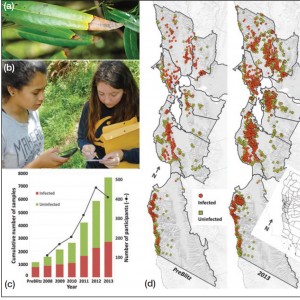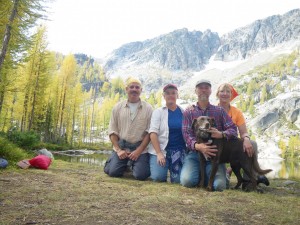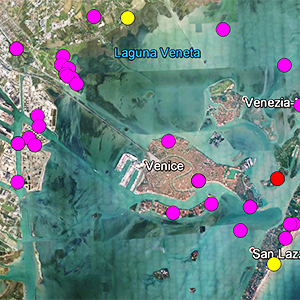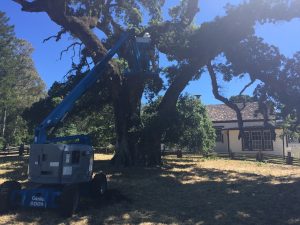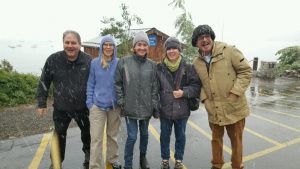Is the SOD Blitz 2020 still on?
Yes! We have developed a specific set of guidelines for the survey this spring please go to the SOD Blitz 2020 page.
Is there a schedule for the SOD Blitz 2020 meetings?
Yes, you can download the meeting schedule here it has contact info for your local organizers. This spring we will not be holding physical meetings in your community. We are asking citizen scientist who would like to participate to go to the online training resource page here.
How can we get the SOD Blitz sampling packets?
Are sudden oak death preventative phosphite treatments effective on madrone?
Preventative treatments are only designed for oaks. To protect madrone, remove any California bay laurel, tanoak, or ornamental rhododendron growing nearby (30 ft around each madrone). However, be careful when doing so as disturbances often affect madrone health.
Is it safe to use tanoak chips on our property if the tanoak died from sudden oak death?
How susceptible are madrones to P. ramorum/sudden oak death (SOD)?
Madrone is very susceptible to P. ramorum (pathogen known to cause SOD), and in rare occasions it may support pathogen sporulation enough to cause infection of nearby oaks. Adult madrones typically experience dieback of infected branches, but they are rarely killed by the pathogen. However, seedlings and saplings can be killed and should be removed if growing within 30 feet of oaks.
I collect and rear acorns for restoration work. How do I tell if the seedlings are healthy before outplanting?
Since there are several native diseases that may affect seedlings, the best approach is to wait at least 1 year following germination before outplanting. Symptoms to look for during this holding time include wilting and leaf spots.
If acorns came from an area with SOD, the situation is a bit more complex. At this point, we have no evidence that SOD may be present as a pathogen in oak acorns or that it may affect oak seedlings; however, “carry over” of spores that are not infecting the seedling may occur if acorns have been collected in very rainy years. While this is likely low risk, if you picked acorns in an area with high or moderate risk of SOD (use the free SODmap mobile app to determine) in a very rainy year, you could be extra cautious and treat acorns with a diluted bleach solution before germinating them.
How susceptible is Italian laurel to P. ramorum/sudden oak death?
Tests conducted on Italian laurel at the UC Berkeley Forest Pathology Laboratory indicate it is moderately to highly susceptible to P. ramorum (pathogen that causes sudden oak death), compared to California bay laurel which is highly susceptible. Based on these results, it is recommended that Italian laurels not be planted in close proximity to oaks.
Does amending soil with gypsum help protect against SOD if a tree is not treated with phosphite?
What are the latest recommendations for protecting high-value oaks from SOD?
Current preventative recommendations for helping to protect high-value oak trees from sudden oak death can be found at New Recommendations for Management of Oaks.
Do the P. ramorum-positive trees on SODMAP remain a risk over time?
SOD advances significantly every time there is a wet year, meaning the SOD expansion cycle goes from wet year to wet year (roughly every 4-5 years). So, any California bay laurel tree identified as positive from 2011 to 2015 is likely still positive. Once the new set of positives associated with the wet 2016/17 season is finalized and mapped, it is probable that many previously negative findings will now be positive. That being said, there are trees that revert their status from SOD positive to “SOD negative.” In a recent study regarding where these “reversals” are more likely to occur (Lione, G.; Gonthier, P.; and Garbelotto, M. 2017. Environmental Factors Driving the Recovery of Bay Laurels from Phytophthora ramorum Infections: An Application of Numerical Ecology to Citizen Science. Forests. 8(8): 293.), it appears that flat and drier areas experience more reversal than other locations. So, if your trees are in an area that receive less rainfall than surrounding trees and you are in a flat and warmer site, you may be in a disease “reversal” area. While these “reversal” sites do seem to occur, at this time we are still using the precautionary principle that once a tree is positive, it is always positive, and should be treated as such.
How close does an oak tree have to be from a P. ramorum-infected bay laurel to be considered at risk of infection?
Risk of oak infection is associated with its distance from ongoing outbreaks. While disease thresholds that increase risk from one level to another have been identified using biological data, these thresholds are only one indicator of many that dictate risk, so it alone cannot be considered conclusive. In general though, if you are approximately 1 km from an outbreak, you are considered to be in an “at risk” area, especially if you are downhill and/or east of an outbreak.
How can I tell if my trees have SOD?
Sudden Oak Death can kill oak and tanoak trees but it vectored, or spread, primarily through the leaves of California bay laurel. You can see what SOD symptoms on bay leaves look like in this picture. In the spring of each year the lab hosts the SOD Blitz Survey Project where you can learn to spot SOD infections, collect leaves on your trees, and have them tested for SOD.
Are there any treatments for SOD?
There are a number of things to keep in mind regarding SOD disease management, you might want to check out these two guides: What to do before SOD arrives in your area and What to do after SOD arrives. There are also preventative chemical treatments available and SOD treatment training workshops conducted at UC Berkeley.
Are there any SOD meetings or workshops?
Yes! There are free meetings and workshops that you can participate in throughout the year:
You may also want to check out the SOD Blitz project webpage for more information.
How can I get my trees tested for SOD?
Our lab does not provide a year-round SOD testing service. However, each spring we conduct the SOD Blitz Survey Project that trains “citizen-scientists” to collect leaf samples in their communities and provides free testing in our laboratory. You might also be interested in seeing how we test for SOD.
What is the phosphite injection protocol for use against SOD?
There are currently two options for injections:
- Chemjet® injectors (coil activated) – volume to be injected = 20 ml; 10% of current label dose; pressure 20 PSI (pressure of injector is already set)
- Arborjet® injectors – volume to be injected = 40 ml; 5% of current label dose; pressure set at 35 PSI
Injections should be done every 2 years. Every year you inject, stagger injection points 2 inches up and 2 inches sideways.
• As a rule of thumb, use one injection every 6 inches, with all injections at the same height.
• Start injections the first year as low as possible on trunk.
• Avoid injecting under branch stubs or punks.
• Injections should take 1-10 minutes to be absorbed. If they are absorbed in less than 1 minute, the material was not absorbed by vessels. If it takes longer than 10 minutes to be absorbed, the timing was not good for the treatment.
• Good days/timing for injections are warm and breezy days between 10 am and 3 pm.
• Leave injection holes unplugged.
Can madrone die from sudden oak death?
Does the sudden oak death pathogen sporulate on madrone like it does on California bay laurel? Sudden oak death can kill small madrones and cause significant dieback of larger madrones. While Phytophthora ramorum (the pathogen that causes sudden oak death) does sporulate on madrone, making in an infectious host, it is not a very effective at transmtting the pathogen as infected leaves whither rapidly, eliminating pathogen viability.
After taking down a P. ramorum-infested bay tree, can the foliage be left onsite to decompose?
Once down, spores from bay foliage will not travel nearly as far as they do in the canopy. The concern on the ground is that infested leaves, while still fresh, could have spores picked up during a wet event from soil splash onto the trunk of the tree. So, spread bay foliage in a thin layer in a sunny area that will promote drying. Be sure to not have foliage near the base of oak or tanoak trunks where soil splash/infection could occur.
I’m considering removal of bay with ramorum blight, but I have symptomatic and asymptomatic tanoak on my property. Will bay elimination protect my oaks and tanoaks?
Both bay laurels and tanoaks can spread SOD while most oaks are not infectious. Therefore, bay removal is typically aimed at protecting oaks. In the absence of bays, you may actually be able to facilitate survival of asymptomatic tanoaks, but only if their density is low (about 20 per acre). A possible plan of action may thus be to eliminate all medium-sized bay trees (up to 20 inch DBH) that are not in a riparian setting and to eliminate all infected tanoaks. You may then decide to leave a few well-spaced tanoaks (50 feet minimum from one another), ensuring none of them are within 30 feet of an oak.
Is it okay to prune coast live oaks in the winter if there is no SOD inoculum in the area? Are there other pests that are active in the winter that are of concern?
Although there may be few insects flying in the winter, the wet winter season (actually fall through spring) is a prime time for production of fruiting bodies by many wood decay fungi. The combination of fresh pruning wounds (especially large wounds), high spore densities of wood decay fungi, and moist conditions (favoring spore germination) can favor new infections by these fungi. From the standpoint of reducing risk of infection by wood decay fungi, pruning in late spring or early summer is probably preferable.
In general, pruning live branches from mature oaks should be kept to a minimum. However, if it is necessary to prune coast live oak branches, as long as they are less than 4″ in diameter, the presence of SOD is not a concern. Though, it is important to prune the oak correctly.
• Make sure you prune right where the tapering of the branch ends from the main stem or even slightly closer to the stem (1/2 in. from the end of the tapering towards the stem).
• Make sure the cut is clean and allows for water to drip without accumulating.
Were the initial outplantings of P. ramorum-infested plants ever traced back to a source nursery?
Phytophthora ramorum was not discovered as the causal agent of sudden oak death until 2000-2001. Prior to then, it was not understood to be a nursery issue; therefore, there was no concern about spread from nurseries into the wildlands. Since then, DNA analysis has confirmed that the pathogen was unknowingly introduced to both California and southern Oregon via infected nursery stock from multiple nurseries. Prior to 2000 and our knowledge of the pathogen, it appears P. ramorum was moving around via the sale and trade of infected ornamental plants and possibly through movement of cuttings or rootstock for production. While we do not know where the pathogen originates from or how ornamental plant nurseries originally were introduced to it, we believe the nursery to wildland introduction in California began around 1987 in Marin and Santa Cruz Counties.
We have bays 100 feet downwind from a coast live oak that seems to be dying of SOD. How do we have our oak tested and how do we determine if the bays are carriers?
Oak testing is routinely done by arborists. It is a rather involved and tedious process that requires a fair amount of finesse and know how as it entails wounding the tree by shaving off the outer layer of bark to collect infected tissue. If you decide to have your oaks tested for SOD, consider going to the Trained Professionals List for arborists that have recently attended an official SOD seminar (Not intended to be a list of recommended professionals, this list does serve as an additional filter when trying to identify arborists that are up-to-date on the latest science-based SOD information.).
Alternatively, a less invasive method of determining the presence or absence of SOD on your property is to sample symptomatic bay leaves (See Hosts and Symptoms for SOD symptoms.). Keep in mind that any infested bay in the general vicinity (typically within 200 ft of an infected oak) may be the inoculum source for infection of your coast live oak. If bay sampling is your preferred method for pathogen detection, you can call your local UC Cooperative Extension office to find out if the California Department of Food and Agriculture is processing leaves from your county and, if so, what the protocol is for sample submissions. In lieu of submitting samples through your county, you can go to www.sodblitz.org to find out when a SOD Blitz will be held in your region (Dates for each year are posted by January 30th. Blitzes typically occur from March to June). Attending a blitz will afford you the opportunity to learn more about SOD, including the latest disease control strategies, during a 1-hour training session. At the end of the session you will be given all sampling materials and instructions for submissions. Blitz participants are free to submit as many leaves as necessary, meaning that you can send in all suspicious leaves from your property as well as from the neighborhood or nearby local parks. All leaves are processed at UC Berkeley and all sampling results are published in a database available at www.sodmap.org or through the free App SODmap mobile.
Does glyphosate (Roundup and other trade names) enhance P. ramorum (sudden oak death) infection?
There is no research or other observational evidence to indicate that glyphosate application increases Phytophthora ramorum infection. In mixed-evergreen and redwood forests some land managers use glyphosate to control invasive weeds, such as French broom, poison oak, and other problematic weeds. In coastal CA, these forest types contain coast live oak, California bay laurel, tanoak, and other plants susceptible to P. ramorum, but the disease is not known to spread or intensify due to glyphosate treatment.
Precautions. Always follow pesticide label instructions and consider non-pesticide alternatives to control pests. Pesticides can be injurious to humans, domestic animals, desirable plants, fish, and other wildlife if they are not handled or applied properly. Use all pesticides selectively and carefully. Follow recommended practices for the disposal of surplus pesticides and pesticide containers.
If a home/landowner suspects SOD is affecting their trees, how do they get them tested?
If a homeowner suspects SOD is affecting their trees, there are a few options to get them tested. SOD kills several oak species and tanoaks, but it is primarily spread via infected California bay laurel leaves. Parties interested in testing for the presence of SOD can contact their local UC Farm Advisor or county Department of Agriculture to find out if they accept symptomatic bay laurel leaves for testing. (Go to Hosts and Symptoms on the California Oak Mortality Task Force [COMTF] website to learn what symptomatic bay leaves look like.)
Another option is to participate in a spring SOD Blitz. These are community-based, volunteer sampling efforts that are organized in cooperation with the Garbelotto lab. Training dates and locations are posted February 1st of each year for the upcoming sampling season at www.sodblitz.org. Training and sampling take just over an hour each and happen on the same scheduled weekend.
For infected oaks, call an arborist. A list of arborists that have attended a SOD training within the last 3 years is available on the Arborists and Applicators page of the COMTF website. NOTE: This list is only intended to be an additional filter for those looking for an arborist. It is not a list of recommended professionals.
We have old camellias and a pittosporum on our property that are healthy, but growing very close to coast live oaks. Should they be removed to help protect the oaks from SOD?
When thinking about P. ramorum dispersal, it is important to think about spread at two scales. First, the pathogen establishes itself on transmissive host leaves (e.g. California bay laurel, tanoak, redwood, rhododendron, and camellia) by moving up to several hundred meters during conducive rain events. Then, as the pathogen builds up, infection can spread from a transmissive host to an oak if it is within 20 m from the oak. If incidence of transmissive hosts is low in your area, chances are that an oak will not become infected even if a camellia or pittospsorum is a few meters away from it, so there is no need to remove these hosts if there are few bay laurels or tanoaks in your neighborhood. The second thing to keep in mind is that SOD is not everywhere. You can use SODmap mobile to help determine current levels of risk for oak infection on your property. If risk is low or negligible, again, there is no need to remove these plants, but they should be monitored for symptoms. The last thing to keep in mind is that the maximum distance between a transmissive host and an oak depends on the size of the transmissive host and on how infectious it may be (i.e. how well does it sporulate). For both camellia and pittosposrum, if the distance between your oak and plants is 10 m or more, they probably represent a low risk. If they are 7 m or less, they may represent a risk if your neighborhood has plenty of transmissive hosts.
Can coast live oak be used in a large-scale Bay Area tree planting project without exacerbating SOD?
Question:
My organization is considering launching a large-scale urban tree planting project in the Bay Area, with the goal of adding one million trees to the urban forest inventory within 15 years. We are interested in coast live oak (CLO) as a major component of the effort for a number of reasons, including the ease with which seed can be collected and planted, drought tolerance, habitat value, high potential for carbon sequestration and rainfall interception, and status as a “signature tree” of the local landscape.
The plan is to gather seed locally from many locations, and plant with minimal site preparation and no supplemental irrigation or other artificial life support systems. Trees will be monitored and cared for over time, and replanting will take place as needed to ensure that we continue to make progress toward our goal. Obviously we don’t want to exacerbate the sudden oak death problem. Our hope is that, on the contrary, widespread and large-scale planting with subsequent monitoring might help identify resistant trees. What recommendations do you have?
Answer:
First of all, this is a really neat project and you are absolutely correct about the benefits of planting CLO. Based on the information provided, the following are recommendations for the project:
In addition to coast live oak, it would also be good to plant Oregon white oak in the northern greater Bay Area, valley oak in the middle portion of the Bay Area, and blue oak in the southern part of the Bay Area. The rationale for this is that diversity/biodiversity is always good and the three alternate oak species are immune to SOD. A good overall planting ratio would be 75% CLO and 25% other species.
The big issue is going to be when California bay laurel is present, as it helps to spread Phytophthora ramorum. CLO should never be planted within 20-25 yards of bay for this reason. Unfortunately, bay has become invasive and SOD is actually increasing its abundance, so where bay is at least 10% of the stand, plant the other oak species recommended above. In riparian areas, bay should be left untouched.
I have an oak tree that is leaking a dark substance 4′ up the trunk, but otherwise it looks healthy. I live in Alameda County. Do I need to be worried about sudden oak death?
Download sod map mobile and tap the risk button. If the risk shows up as high or moderate, call an arborist listed at http://www.suddenoakdeath.org/diagnosis-and-management/arborists-applicators/. If you get an insufficient data response, then see if you have any CA bay laurel trees within 20 yards of the oak. If you find any, do they have possible P. ramorum (pathogen that causes sudden oak death) symptoms (symptomatic photos: http://www.suddenoakdeath.org/library/photos/plant-symptom-photos/; host information: http://www.suddenoakdeath.org/diagnosis-and-management/hosts-and-symptoms/). If you do find questionable symptoms on bay, again, call an arborist listed at http://www.suddenoakdeath.org/diagnosis-and-management/arborists-applicators/ for a site visit.
What are the revised SOD treatment recommendations that were released in June 2015?
The revised SOD treatment recommendations can be found at: https://nature.berkeley.edu/matteolab/?p=1039.
My coast live oak trunk is oozing. I sprayed the bark in January. Can you estimate how long it will be before the tree fails and we have to remove it?
The symptoms on your oak may be caused by a range of issues. If oozing is accompanied by the presence of fine sawdust, then the tree is dying. Even if it is still green you may want to consider removing it if its failure may cause harm to people or property. The fine sawdust is caused by beetles tunneling in the tree. Oaks are only attacked by beetles when dying. If no sawdust is present, then the tree’s condition may be reversible.
Unfortunately, it is difficult to determine what may be the cause of the symptoms you describe. Sudden Oak Death (SOD) can attack an oak tree if California bay laurel is within 60 feet of the oak. You can use the free SODmap Mobile App to determine if you are in a high or moderate risk zone for SOD. To find out how to do that, go to www.sodmapmobile.org. There is also a YouTube video you can watch at https://youtu.be/zE0_q3EmIfs. If the information you gather suggests that it may be SOD, then repeat the phosphite bark application (such as Agri-Fos® combined with Pentra-Bark®) in the fall between October 30th and December 15th. You may also want to consider removal of bays within 30 feet from the oak. Go to http://nature.berkeley.edu/matteolab/?page_id=909 to find out about upcoming treatment training sessions to learn more about treatment options. If there are no bays within 60 feet of your oak and the SODmap mobile risk is low, then it likely isn’t SOD.
If you have watered your oak, it may be a root disease such as the oak root fungus or Phytophthora cinnamomi root disease. Make sure you stop watering and expose the upper root system to the air to slow disease progression. If you have never watered your oak, then it may be a secondary disease brought on by the long drought (ex. oak die-back fungus). These are diseases that are strongly affected by the genetics of the tree and weather conditions. In this case, you may want to try watering the tree now and then once again in 2 weeks. Then water once a month starting October 15th. Do not water between July 10th and October 15th. Watering should be done using a low flow approach to ensure that the soil gets wet up to 1 foot down and that no flooding of the tree ever occurs. Unfortunately, if the secondary disease is too advanced, despite all efforts, the tree may still die.
Can I apply phosphonate to my oak trees to help prevent SOD or do I need a professional?
Yes, you can apply phosphonate to your oak trees to help protect them from sudden oak death. You can find it in many Bay Area garden supply stores.
If you apply it topically to the bark, you will also need the surfactant Pentra-Bark® and you will need a sprayer. If you choose to inject it, you will need enough injectors to treat your largest tree (1 injector every 6 inches around the circumference). Treatments should be applied between November 1st and December 15th for best results.
For details on how to apply phosphonates, go to www.matteolab.org, “Treatment and Diagnosis” (at top of page).
Are there any P. ramorum-resistant coast live oaks or tanoaks commercially available?
Research has identified coast live oak individuals that may be somewhat resistant to SOD, possibly because of the presence of some chemicals in the bark and phloem. However, there is no information yet on how genetics and the environment may affect this trait.
Tanoak has some mother trees that produce SOD-tolerant seedlings and some that produce seedlings that respond very well to phosphonate treatments. These tanoak families are at UC Berkeley, but are not currently commercially available.
Does phosphonate act as a vaccine, keeping trees from getting SOD?
Phosphonate is only intended to be used on trees that do NOT have sudden oak death (SOD). Once a tree is infected, it is of no use. It helps to boost the tree’s own immunity system against the pathogen. So, if a tree is very susceptible to P. ramorum (the pathogen that causes SOD), then it may still get infected and die, even with the phosphonate treatment. Really, the phosphonate just helps increase the odds that a moderately susceptible tree will be able to ward off infection. So, it is an odds game and you are just increasing your odds of success. Variables that contribute to success include tree susceptibility, disease pressure in the area, hosts present in the area, and environmental conditions.
How often should SOD phosphite treatments be applied?
If SOD phosphite treatments are being applied by injection November 1st – December 15th, data has shown that treating every 2 years is sufficient. When preparing the injections, be sure to use the most current dosage recommendations as they have recently been updated. Current recommendations can be found at http://nature.berkeley.edu/matteolab/?page_id=2345. The new dosages are significantly more diluted than the original label dosages, yet are just as effective and cause almost no damage to the wood (the original label dosages do cause some wood damage).
If SOD phosphite treatments are being applied using a topical bark application, treat every 1 – 2 years. While data has shown that topical applications last for 18 months, fall treatments are the most effective. Therefore, in a county known to be infested, treat trees in riparian areas, within 20 miles of the coast, or within 2 miles of redwood forests every year. Treat trees in drier areas (of infested counties) every 2 years.
Can poison oak leaves be infected by Phytophthora ramorum?
Will the spray application for SOD prevention be updated like the injection application was?
Do azomite fertilization and lime wash treatments help control SOD?
Based on the study published by the UC Berkeley Garbelotto lab in California Agriculture (http://nature.berkeley.edu/garbelotto/downloads/calag2009.pdf), azomite and/or lime washes alone are not effective in controlling SOD.
What temperature range is acceptable for treating oak trees with phosphonate?
When treating large oak trees with phosphonate, is it more effective to topically apply or inject the material?
When will the 2017 SOD Blitz and training sessions be held?
SOD Blitzes include a training session for blitz volunteers on SOD and proper sampling, followed by time in the field for collecting and marking sample locations. All necessary collection materials are provided to volunteers during the training session for use either the same day of the training or the day after. All samples are to be dropped off at a designated location (location announced at the training session). There are approximately 20 SOD Blitzes in areas of California that have sudden oak death or at risk of disease establishment. Most of the training sessions are offered on Saturday mornings. SOD Blitz schedules for the coming year are posted annually during the last week of January at www.sodblitz.org.
How long can Phytophthora ramorum survive in soil moved from an infested area?
Survival of P. ramorum (SOD pathogen) in dead hosts or non-plant substrates is extremely variable and strongly affected by climatic factors. Although a comprehensive study on this topic has not conducted, extrapolating from several studies we can say the following:
Soil becomes more infectious from late winter to early summer in the presence of rainfall, so any movement of soil away from a SOD-infested area from January to July could transport viable P. ramorum.
Keep the following in mind:
- The larger the volume of soil moved, the greater the risk.
- In organic rich soils (e.g. top layers of forest soils), pathogen survival is less than 18 months.
- If P. ramorum is present in green waste incorporated in the soil, survival can be much longer (2 years or more).
- In inert soils (e.g. potting mix), the pathogen can survive multiple years. However, for all soils, areas with less temperate climates (cold winters, hot summers) may hasten loss of pathogen viability.
From a practical perspective, if infested forest soil is picked up on tires or shoes from late winter to early summer, the pathogen will likely remain viable for about 1 year, in the absence of incorporated green waste. If soil is picked up from late summer to early fall, survival duration is much less, possibly in the order of a few months.
How long can Phytophthora ramorum survive in wood chip mulch?
Survival of P. ramorum (SOD pathogen) in wood chips depends on a few factors:
- Were the chips allowed to become wet?
- What size are the chips?
- Is green waste present?
- What time of year was the wood chipped?
- Where in California are the chips located?
Chips that are piled wet or tarped and include infected green waste (e.g. bay laurel leaves) may support pathogen viability for over 1 year, especially in mild coastal areas. If the wood is chipped in the summer and early fall and the chips are not piled, but rather broadcast in a 1-inch layer in a dry and sun-exposed area, pathogen viability may only be supported for a few weeks, especially if in hotter interior areas.
I have an oak in the Bay Area that is oozing liquid from the trunk base. Should I test it for SOD? If so, how?
When trying to determine if an oak may have SOD (caused by the plant pathogen Phytophthora ramorum), the first step is to determine if the tree lies within 1 km of a known outbreak. This can be done by accessing SODMAP at www.sodmap.org or by uploading the free “SODMAP Mobile” app to your smartphone. Stand next to the tree in question and tap the risk button. A response of moderate or high risk would suggest Phytophthora ramorum may be present. The next step is to confirm it is indeed P. ramorum. Make sure the oozing is not wetwood, or bacterial flux, which typically is associated with much more oozing and often has an unpleasant odor. Bacterial flux usually has a watery secretion running down the trunk that originates from a wound or branch crotch. If all symptoms align with SOD, the next step is to test for P. ramorum. If a symptomatic California bay laurel tree is within 10 m of the oak, collect symptomatic bay leaves for testing. This is not a definite diagnosis for the oak, but it may be an acceptable one that does not involve wounding the oak tree for sampling. Bay-based diagnosis for an oak may be less accurate after multiple years of drought, as bays may actually turn from SOD positive to SOD negative during extended dry conditions. One can get bay leaves tested by participating in one of the annual SOD blitzes (www.sodblitz.org) or by submitting samples to the California Department of Food and Agriculture. Testing the oak requires debarking a portion of the tree until the margins of the putative SOD lesion under the bark are visible and then plating the margins of the lesion on Phytophthora-selective medium for laboratory analysis.
Does rain affect preventative phosphite (e.g. Agri-Fos®) treatments for oaks?
When treating oak trees with phosphites to help prevent SOD, it may be beneficial to apply the topical treatment to bark that is dry. Rain occurring after the treatment (even immediately after) does not affect the application. If injecting phosphites, it may be better to avoid rainy days, as lower evapotranspiration is often documented for trees in such conditions. Lower evapotranspiration rates may result in poor tree absorption of phosphites.
Note: Topical treatments are most effective when applied in the fall, from November to early December. Injections should only be performed from fall to early winter.
I just cut down a small infected bay. Do the root shoots carry P. ramorum?
Bay shoots do not carry P. ramorum because the pathogen is not systemic in bay. Each leaf is infected independently. Additionally, there is no root infection in most P. ramorum hosts, particularly California bay laurel. However, when bays re-sprout, they may be re-infected.
I have a very small bay tree that has leaves with P. ramorum symptoms. Should I just remove the tree or take a sample first?
It is always advisable to first have a tree tested before removal to be sure P. ramorum is present. If you are noticing symptoms in spring, attend a nearby SOD Blitz for information on sampling and lab submissions. For more information, go to sodblitz.org.
How do I determine the distance from trees on my property to P. ramorum-positive trees on SODmap?
When looking at SODmap, you may wonder if P. ramorum-positive trees are close enough to pose a threat to trees on your property. Use the free App SODmap mobile to get the answer. Just tap the App risk function and it will tell you whether infected trees trees are within 200 m (high risk) or 1,000 m (moderate risk). If infected trees are further than 1,000 m, risk is typically low. Alternatively, you can use Google Earth, tapping the icon with a “ruler” on the top bar. Click your mouse on the closest infected tree and then move the mouse to your property. Be careful to actually move the mouse all the way to an oak tree within your property. The mouse should be drawing a line when you go from the infected tree to your oak. When you click the mouse again on top of the oak on your property, the ruler will tell you the distance. The following is suggested:
- As the crow flies, measure from any infected tree to any oak of interest.
- Repeat the measurement process using 3 different infected trees that appear to be close to your property.
- If distance is slightly higher than 200 m (high risk) or 1,000 m (moderate risk), but your property is downhill and/or downwind, you may still consider your oaks to be at risk.
How can I be sure I’m not spreading SOD with my tools?
The most important part of ensuring that tools will not spread SOD is to be sure that no organic debris or soil is present on the tools. This applies to all portions of each tool, including parts that may not be visible (like the return of a chain in a chainsaw or the interior of a tree chipper). For more information on cleaning tools and equipment, go to https://nature.berkeley.edu/matteolab/?p=1208.
How often do you administer phosphonate to oaks to help protect them from sudden oak death?
Phosphonate injection treatments to help prevent sudden oak death infection of susceptible oak species (coast live oak; California black oak, Shreve’s oak, and canyon live oak), if applied in the fall (after October 30th ), need only to be applied once every other year (biannual frequency). If your first phosphonate treatment is in the spring, then treat again in the fall (after October 30th) and then treat once every other year.
If applying phosphonate as a bark application in conjunction with the surfactant PentraBark®, then one fall treatment each year is the prescription. If you apply it the first time in the spring, apply again in the fall after October 30th and then apply again in the fall of each year (after October 30th).
How do I clean my tools well enough to ensure I’m not spreading sudden oak death?
The most important part of ensuring that tools will not spread sudden oak death is to be sure that no organic debris or soil is present on the tool. This applies to all portions of the tool, including parts that may not be visible (like the return of a chain in a chainsaw or the interior of a tree chipper).
If reforesting an area impacted by SOD with local acorns, what can be done to prevent spreading the pathogen during planting?
Take the following precautions when using local acorns for oak reforestation projects in areas impacted by SOD to help minimize pathogen spread.
- Place acorns in a 10% dilution of bleach for 10 minutes then rinse twice with tap water.
- Make sure volunteers’ shoes are free of soil, mud, and organic material.
- Be sure tools being used are clean and free of soil, mud, and organic material.
My redwood has severe dieback and is near a coast live oak with SOD. Could the redwood have SOD?
Most likely the redwood is experiencing symptoms related to cycles between drought and rainy periods. However, if there is a significant presence of California bay laurels intermixed with redwoods, there may be enough pressure from the SOD pathogen to also cause problems on redwoods, both native and exotic. Any SOD oak infections are likely directly connected to bay laurels, as both oaks and redwoods can become infected by the large number of spores produced on bay laurel leaves. The pathogen does not move from oaks to other trees.
How do I know if my area has been evaluated for sudden oak death?
If you live in a California county that is known to have sudden oak death (SOD), you can check to see if your area has been evaluated for the presence of the pathogen that causes SOD (Phytophthora ramorum) by downloading the free SODMAP Mobile app. Doing so will allow you to see if trees have been sampled in your area, what species were sampled, what year they were sampled, and if they were positive or negative for the pathogen. While the app is fairly intuitive, if you need instruction on how to use it, go to sodmapmobile.org.
How susceptible are canyon live oaks to Phytophthora ramorum?
Canyon live oak is an intermediate oak, meaning it is between the red and white oak groups. P. ramorum/SOD primarily infects only red oaks; however, it does also affect the intermediary canyon live oak. In northern California (Humboldt County), canyon live oak infected with P. ramorum leads to dieback of large branches. In the Bay Area, large canyon live oaks have been found dying from P. ramorum/SOD. If you are in central coastal California in an area known to have SOD and canyon live oaks are present with California bay laurels nearby, consider clearing bays (even the little ones) within 20 feet of large (> 1 foot diameter) individuals.






